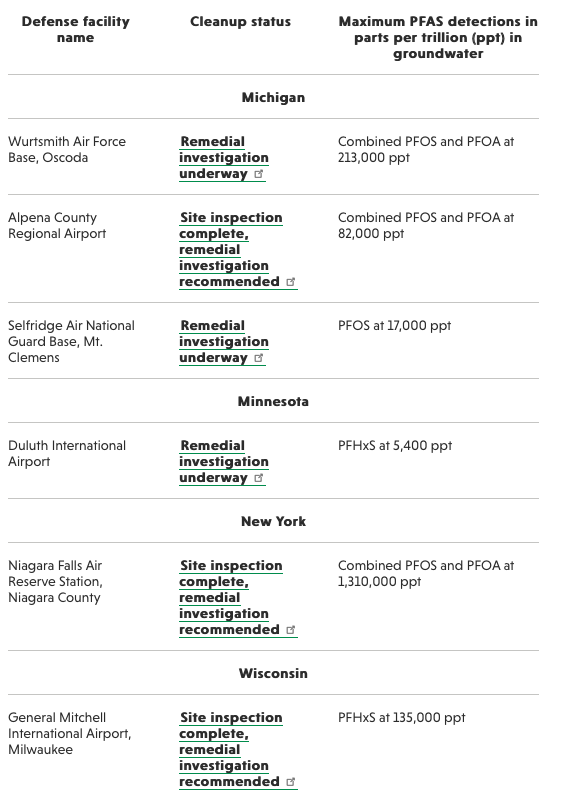‘Forever Chemicals’ Contamination at Defense Department Sites Threatens Great Lakes Fish and Residents

All Global Research articles can be read in 51 languages by activating the “Translate Website” drop down menu on the top banner of our home page (Desktop version).
Visit and follow us on Instagram at @crg_globalresearch.
***
Groundwater from at least six Defense Department sites in the Great Lakes region is contaminated with high levels of the toxic “forever chemicals” known as PFAS, according to DOD records obtained by EWG.
The chemicals have seeped into the Great Lakes, adversely affecting wildlife, and potentially harming residents’ food supply and livelihoods if they consume fish contaminated with the chemicals. The contamination underscores the need for swift PFAS cleanup by DOD, which used these chemicals in firefighting foams for decades and knew of their harms.
DOD’s records reveal levels of PFAS, including the notorious chemicals PFOA and PFOS, ranging from 5,400 parts per trillion, or ppt, to 1.3 million ppt, in the groundwater at the six sites. There is no enforceable federal drinking water limit for PFAS, but Michigan’s groundwater cleanup criteria and drinking water standards are 8 ppt for PFOA and 16 ppt for PFOS.
The highly contaminated DOD sites include:
- Wurtsmith Air Force Base
- Alpena Combat Readiness Training Center
- Selfridge Air National Guard Base
- Duluth Air National Guard Base
- Niagara Falls Air Reserve Station
- General Mitchell Air National Guard Base
The records also show that PFAS may be present in the groundwater at several other bases near the Great lakes where DOD has not tested to confirm the presence of PFAS, including:
- Great Lakes Naval Service Training Command
- Fort Sheridan
- Gary Army Aviation Support Facility

PFAS cleanup lags at Great Lakes military bases
DOD’s efforts to clean up PFAS at the affected bases are still in the earliest stages, according to EWG’s review of the department’s records.
PFAS from these sites could be harming the Great Lakes’ wildlife, including lake trout, walleye and smelt, posing potential health risks to anyone who consumes the contaminated fish.
There are no federal guidelines establishing a safe level of PFAS consumption.
PFAS are known as forever chemicals because they build up in our bodies and do not break down in the environment. Studies show that exposure to extremely low levels of PFAS can increase the risk of cancer, harm fetal development and reduce vaccine effectiveness.
Testing fish for PFAS contamination
No national standard exists for testing fish for PFAS. But the Environmental Protection Agency, collaborating with the Navy, aims to finalize a test method this year.
In 2019, the Food and Drug Administration also created its own tests for the presence of 16 PFAS chemicals in foods across eight mid-Atlantic states, focusing on the most commonly consumed foods available in grocery stores, not locally caught or raised foods. The FDA detected PFOS in half of the seafood sampled. Fish from the Great Lakes was not included.
Some studies have found troubling levels of PFOS in Lake Erie trout. A recent study found PFAS concentrations in Great Lakes trout increased from west to east, with the highest concentrations in Lake Erie. The average concentrations ranged from 11 nanograms per gram, or ng/g, in trout from Lake Superior to 136 ng/g in Lake Erie. Other studies have found PFAS in Great Lakes salmon, round gobies and other aquatic species.
The European Food Safety Authority, or EFSA, set a consumption threshold of 4.4 ng/g per week. For a 160-pound person, a safe level of exposure to PFAS in food for an entire week would be 332 ng/g. One 8-ounce serving of lake trout, at 11 ng/g, would be more than seven times this weekly limit, and one trout from Lake Erie with 136 ng/g of PFAS would be almost 100 times more than this weekly limit.
EFSA lowered its level for PFAS in food because new research shows that exposure to PFAS reduces vaccine efficacy. In the midst of the coronavirus pandemic, EFSA scientists considered that to be the most critical human health effect.
Several states, including Michigan and Wisconsin, are now offering guidelines to limit consumption of fish contaminated with PFAS. Michigan has started to issue an annual guide for the fishing community that includes the location of contaminated fish populations and the amount of each type that is safe to consume. High PFAS levels in smelt in Lake Superior have led Wisconsin officials to issue a fish consumption advisory.
Decades of contamination at DOD sites
Although PFAS contamination of the Great Lakes is suspected from hundreds of industrial sites throughout the region, DOD sites are a major contamination source.
The potential threat to Great Lakes wildlife from PFAS contamination at DOD sites is a local example of a national problem. The chemicals have been detected at more than 300 military installations across the U.S., and they may be present at hundreds of other military sites.
The primary source of PFAS at military bases is aqueous firefighting film-forming foam, or AFFF, developed by DOD in the 1960s and first required by the Navy and the Marine Corps in 1967. Legacy formulations of AFFF, used for decades, contained PFOS and PFAS precursors that can break down into PFOA and other toxic PFAS.
DOD has long known about the toxic effects of PFAS pollution. In 1973, an Air Force report cited the toxic effects of AFFF on fish and recommended the use of carbon filters for drinking water to prevent contamination. Subsequent Air Force and Navy reports, in 1974, 1976 and 1978, also cited the toxic effects of AFFF on fish.
In 1983, animal studies financed by the Air Force found that some PFAS were toxic. In 1985, Navy experts again cited the toxic effects of AFFF on fish and, in 1989, called for better management of AFFF waste.
In 2000, DOD learned that 3M planned to stop making AFFF, after internal studies showed evidence of its health hazards. A 2001 DOD memo concluded the main ingredient in AFFF was “persistent, bioaccumulating, and toxic.” Months later, an EPA official reiterated to the department the risks posed by PFOS and the entire class of PFAS.
But DOD officials waited another decade to issue a risk alert to service members. It did not take steps to begin to replace AFFF until 2015 – despite a 1991 Army Corps of Engineers recommendation to use nonhazardous substitutes.
Push for PFAS testing at DOD sites
Newer PFAS in replacement foams have been linked to many of the same health effects as those from PFOS, leading Congress to direct the department to phase out the use of fluorinated foams altogether by 2024.
Many viable alternatives to AFFF are already on the market, and already meet the international aviation foam standards used by airports all over the world. As of April 2019, more than 100 fluorine-free foams were available, from 24 manufacturers.
Last month, DOD’s inspector general faulted the department for moving too slowly to address the PFAS contamination crisis.
And earlier this summer, the Senate Armed Services Committee included provisions in the National Defense Authorization Act for fiscal year 2022 to set deadlines for PFAS testing and reporting at DOD sites but failed to set deadlines for cleanups.
The House Armed Services Committee will take up its version of the bill on September 1. Panel members from Great Lakes states include Reps. Jack Bergman (R-Mich.), Mike Gallagher (R-Wisc.), Lisa McClain (R-Mich.), Elissa Slotkin (D-Mich.), Elise Stefanik (R-N.Y.) and Michael Turner (R-Ohio). Slotkin and Turner have introduced legislation to address PFAS contamination and DOD sites and are expected to offer several amendments to the bill.
*
Note to readers: Please click the share buttons above or below. Follow us on Instagram, @crg_globalresearch. Forward this article to your email lists. Crosspost on your blog site, internet forums. etc.
Featured image is from EWG


